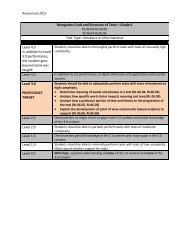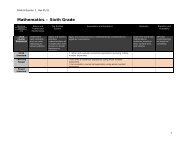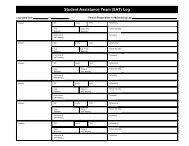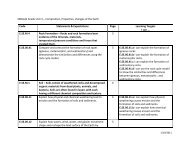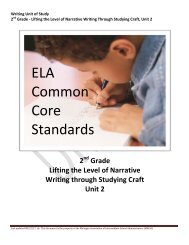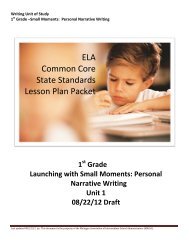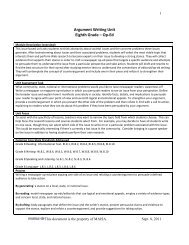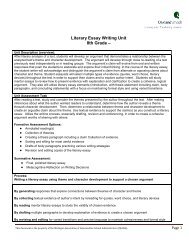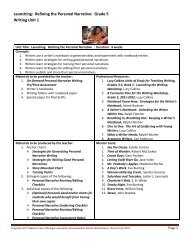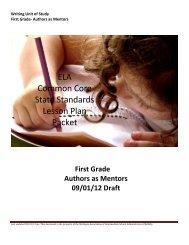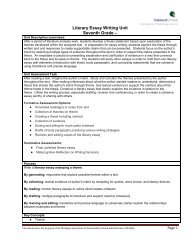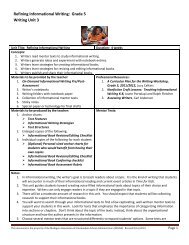COLLEGE READINESS STANDARDS
ACT's College Readiness Standards
ACT's College Readiness Standards
- No tags were found...
You also want an ePaper? Increase the reach of your titles
YUMPU automatically turns print PDFs into web optimized ePapers that Google loves.
<strong>COLLEGE</strong> <strong>READINESS</strong>TM<strong>STANDARDS</strong>For EXPLORE ® , PLAN ® , and the ACT ®Includes Ideas for Progress
ContentsIntroduction . . . . . . . . . . . . . . . . . . . . . . . . . . . . . . . . . . . . . . . . . . . . . . . . . . 2English . . . . . . . . . . . . . . . . . . . . . . . . . . . . . . . . . . . . . . . . . . . . . . . . . . . . . . . 4Mathematics . . . . . . . . . . . . . . . . . . . . . . . . . . . . . . . . . . . . . . . . . . . . . . . . . 10Reading . . . . . . . . . . . . . . . . . . . . . . . . . . . . . . . . . . . . . . . . . . . . . . . . . . . . . 18Science . . . . . . . . . . . . . . . . . . . . . . . . . . . . . . . . . . . . . . . . . . . . . . . . . . . . . . 26Writing . . . . . . . . . . . . . . . . . . . . . . . . . . . . . . . . . . . . . . . . . . . . . . . . . . . . . . 30ACT Offices . . . . . . . . . . . . . . . . . . . . . . . . . . . . . . . . . . . . . . . . . . back coverWhat doEXPLORE, PLAN,and ACT scorestell me about whatmy students know?IntroductionCollege Readiness Standards TM and the EPAS ® SystemACT’s Educational Planning and Assessment System (EPAS) is anintegrated series of assessment and career planning programs—EXPLORE ®(grades 8 and 9), PLAN ® (grade 10), and the ACT ® (grades 11 and 12)—designed to help students increase their academic readiness for college.Specifically, each program measures student achievement in English,mathematics, reading, and science. (The ACT also includes an optionalWriting Test.) EPAS, a curriculum- and standards-based system, is ideal forconnecting teaching, learning, and assessment to impact student growthfrom grade 8 through 12.At the foundation of the EPAS programs are ACT’s College ReadinessStandards. The Standards offer learning strategies that are likely to helpstudents meet state standards and acquire the more advanced conceptsassociated with higher EPAS test scores and, more importantly, increasedcollege readiness.What Are ACT’s College Readiness Standards?College Readiness Standards are detailed, research-based descriptions ofthe skills and knowledge associated with what students are likely to knowand to be able to do based on their EXPLORE, PLAN, and/or ACT testscores. For each content area—English, mathematics, reading, and science—Standards are provided for six score ranges along a scale common toEXPLORE (1–25), PLAN (1–32), and the ACT (1–36). Standards for theoptional ACT Writing Test have also been developed, although on adifferent score scale (2–12). The Standards are organized by strands—thecolumn headings at the top of the page.2The common score scale ensures that skills associated with each score rangeare identical regardless of the test used to obtain the score. As the testsincrease in complexity from EXPLORE to PLAN to the ACT, theStandards ranges reflect this. Therefore, Standards for the 28–32 scorerange are specific to PLAN and the ACT, while those for the 33–36 scorerange are specific to the ACT only.
Since the EPAS programs measure students’ progressive academicdevelopment, the Standards are cumulative. That is, a student scoring in the24–27 score range is likely able to demonstrate the skills associated with the13–15, 16–19, and 20–23 score ranges as well. This enables EPAS toprovide seamless data describing student achievement over time from grade8 through 12.Why Are College Readiness Standards Needed?The Standards were developed in response to the need for betterinformation about student achievement and to answer the often-askedquestion, What does a given score on EXPLORE, PLAN, or the ACTreally mean? The Standards serve as a direct link between what studentshave learned, what they are ready to learn next, and what they must learnbefore leaving high school in order to be prepared for college. TheStandards are an effective tool for enhancing student learning based on testscores that students earn. The Standards are complemented by ideas forprogress—brief descriptions of learning experiences from which studentsmight benefit.What Are ACT’s College Readiness Benchmark Scores?While the College Readiness Standards describe the skills students likelyhave based on their EPAS test scores, ACT’s College Readiness BenchmarkScores, given in the table below, are early indicators of likely collegesuccess based on those same scores. College Readiness Benchmark Scoresfor the ACT represent median test scores that are predictive of studentsuccess* in relevant college courses. The EXPLORE and PLANBenchmark Scores are indicative of probable readiness for college-levelwork by the time the student graduates from high school. Used together,the Standards and the Benchmark Scores provide an effective means forcommunicating college readiness expectations to middle and high schoolsand for measuring progress toward them.*Success is definedas a 50% or higherprobability ofearning a B orhigher in thecorrespondingcollege course orcourses.College Readiness Benchmark ScoresEXPLORE PLAN ACTSubject Test Test Score Test Score Test ScoreGrade 8 Grade 9English 13 14 15 18Mathematics 17 18 19 22Reading 15 16 17 21Science 20 20 21 243
Sentence Structure and Formation Conventions of Usage Conventions of Punctuation■■vary sentence length by combiningsimple sentencescheck writing to make sure verb tensesare consistent■make sure to use adjectives like well,less, and worst correctly■learn to recognize when commas areoverused■■Use conjunctions or punctuation to joinsimple clausesRevise shifts in verb tense betweensimple clauses in a sentence or betweensimple adjoining sentences■Solve such basic grammatical problemsas how to form the past and pastparticiple of irregular but commonly usedverbs and how to form comparative andsuperlative adjectives■Delete commas that create basic senseproblems (e.g., between verb and directobject)■revise writing to correct glaring shifts inverb tense or voice■■revise writing to correct basic grammarand punctuation errorspractice and understand correct usageof common homonyms (e.g., their/there,past/passed)■■practice using punctuation correctly insimple sentences (e.g., “He ran, jumped,and swam.”)check for and correct unnecessarycommas■■Determine the need for punctuation andconjunctions to avoid awkward-soundingsentence fragments and fusedsentencesDecide the appropriate verb tense andvoice by considering the meaning of theentire sentence■■Solve such grammatical problems aswhether to use an adverb or adjectiveform, how to ensure straightforwardsubject-verb and pronoun-antecedentagreement, and which preposition touse in simple contextsRecognize and use the appropriate wordin frequently confused pairs such asthere and their, past and passed, andled and lead■■Provide appropriate punctuation instraightforward situations (e.g., items ina series)Delete commas that disturb the sentenceflow (e.g., between modifier andmodified element)■experiment with writing moresophisticated sentences; check toensure verbs agree with subjects andmodifiers don’t dangle■revise sentences to ensure that eachverb agrees with its subject when thereis some text between the two■use commas to set off parentheticalphrases5
ENGLISH(continued)<strong>COLLEGE</strong> <strong>READINESS</strong> <strong>STANDARDS</strong>ScoreRangeTopic Development in Termsof Purpose and FocusOrganization, Unity, andCoherenceWord Choice in Terms of Style,Tone, Clarity, and Economy20–23Standards■■Identify the central idea or maintopic of a straightforward pieceof writingDetermine relevancy whenpresented with a variety ofsentence-level details■■■Use conjunctive adverbs orphrases to express straightforwardlogical relationships(e.g., first, afterward, inresponse)Decide the most logical place toadd a sentence in an essayAdd a sentence that introducesa simple paragraph■■■Delete redundant materialwhen information is repeated indifferent parts of speech (e.g.,“alarmingly startled”)Use the word or phrase mostconsistent with the style andtone of a fairly straightforwardessayDetermine the clearest andmost logical conjunction to linkclausesideas forprogress■■continue reading the work ofwriters of various genres; beginexperimenting with a variety ofwriting stylesrevise fairly straightforwardwriting to sharpen focus andcoherence of entire piece■■■experiment with using wordsand phrases that create cleartransitions in writingrearrange sentences in aparagraph in order to improveits coherencewrite introductions that capturethe reader’s interest, writeconclusions that provide asense of closure, and describethe rhetorical effects that eachcreates■■continue to edit sentences forempty language, wordiness, andredundancyrevise structurally complexsentences to correct vague orambiguous pronoun references24–27Standards■■■Identify the focus of a simpleessay, applying that knowledgeto add a sentence that sharpensthat focus or to determine if anessay has met a specified goalDelete material primarilybecause it disturbs the flow anddevelopment of the paragraphAdd a sentence to accomplisha fairly straightforward purposesuch as illustrating a givenstatement■■■Determine the need forconjunctive adverbs or phrasesto create subtle logicalconnections between sentences(e.g., therefore, however, inaddition)Rearrange the sentences in afairly uncomplicated paragraphfor the sake of logicAdd a sentence to introduceor conclude the essay or toprovide a transition betweenparagraphs when the essay isfairly straightforward■■■Revise a phrase that isredundant in terms of themeaning and logic of the entiresentenceIdentify and correct ambiguouspronoun referencesUse the word or phrase mostappropriate in terms of thecontent of the sentence andtone of the essayideas forprogress■■develop awareness of ways thatform and content can bechanged as the audience forthe writing changeslearn how meaning can beexpressed through connotation■■experiment with more subtleorganizational structuresrevise writing by refiningintroductions, conclusions,and transitions in complexparagraphs■■select and manipulate words,phrases, and clauses to conveyshades of meaning and toneavoid clutter and use vividverbs and specific nouns6
Sentence Structure and Formation Conventions of Usage Conventions of Punctuation■Recognize and correct markeddisturbances of sentence flow andstructure (e.g., participial phrasefragments, missing or incorrect relativepronouns, dangling or misplacedmodifiers)■■Use idiomatically appropriateprepositions, especially in combinationwith verbs (e.g., long for, appeal to)Ensure that a verb agrees with its subjectwhen there is some text between the two■■Use commas to set off simpleparenthetical phrasesDelete unnecessary commas when anincorrect reading of the sentencesuggests a pause that should bepunctuated (e.g., between verb anddirect object clause)■■revise writing to correct faultycoordination and subordination ofclausesrevise sentences to correctinconsistencies in verb tense andpronoun person■check to be sure pronouns agree withantecedents in increasingly complexsentences■■use punctuation to set off nonessentialinformation in a sentencerecognize inappropriate uses ofcommas■■Revise to avoid faulty placement ofphrases and faulty coordination andsubordination of clauses in sentenceswith subtle structural problemsMaintain consistent verb tense andpronoun person on the basis of thepreceding clause or sentence■■Ensure that a pronoun agrees with itsantecedent when the two occur inseparate clauses or sentencesIdentify the correct past and pastparticiple forms of irregular andinfrequently used verbs and formpresent-perfect verbs by using haverather than of■■■■Use punctuation to set off complexparenthetical phrasesRecognize and delete unnecessarycommas based on a careful reading of acomplicated sentence (e.g., between theelements of a compound subject orcompound verb joined by and)Use apostrophes to indicate simplepossessive nounsRecognize inappropriate uses of colonsand semicolons■use sentence-combining techniques tocreate more sophisticated sentences;check to avoid fragments, commasplices, and run-ons■recognize the difference between its andit’s, your and you’re, who and whom■■use commas to set off nonessentialappositives or clausesuse semicolons to indicate relationshipsbetween independent clauses7
ENGLISH(continued)<strong>COLLEGE</strong> <strong>READINESS</strong> <strong>STANDARDS</strong>ScoreRangeTopic Development in Termsof Purpose and FocusOrganization, Unity, andCoherenceWord Choice in Terms of Style,Tone, Clarity, and Economy28–32*Standards■■Apply an awareness of thefocus and purpose of a fairlyinvolved essay to determine therhetorical effect and suitabilityof an existing phrase orsentence, or to determine theneed to delete plausible butirrelevant materialAdd a sentence to accomplisha subtle rhetorical purpose suchas to emphasize, to addsupporting detail, or to expressmeaning through connotation■■■Make sophisticated distinctionsconcerning the logical use ofconjunctive adverbs or phrases,particularly when signaling ashift between paragraphsRearrange sentences to improvethe logic and coherence of acomplex paragraphAdd a sentence to introduceor conclude a fairly complexparagraph■■Correct redundant materialthat involves sophisticatedvocabulary and soundsacceptable as conversationalEnglish (e.g., “an aestheticviewpoint” versus “the outlookof an aesthetic viewpoint”)Correct vague and wordy orclumsy and confusing writingcontaining sophisticatedlanguageideas forprogress■■write essays that indicate aheightened awareness of theaudience for those essaysrecognize the role that specificsentences play in terms of theessay as a whole■revise or add introductorysentences or transitions basedon an understanding of the logicand rhetorical purpose of theparagraph and the essay as awhole■revise writing to deleteredundancies in terms of theparagraph as a whole33–36†Standards■■Determine whether a complexessay has accomplished aspecific purposeAdd a phrase or sentence toaccomplish a complex purpose,often expressed in terms of themain focus of the essay■Consider the need forintroductory sentences ortransitions, basing decisionson a thorough understanding ofboth the logic and rhetoricaleffect of the paragraph andessay■Delete redundant material thatinvolves subtle concepts or thatis redundant in terms of theparagraph as a whole* PLAN and ACT only† ACT only8
Sentence Structure and Formation Conventions of Usage Conventions of Punctuation■■Use sentence-combining techniques,effectively avoiding problematic commasplices, run-on sentences, and sentencefragments, especially in sentencescontaining compound subjects or verbsMaintain a consistent and logical use ofverb tense and pronoun person on thebasis of information in the paragraph oressay as a whole■■Correctly use reflexive pronouns, thepossessive pronouns its and your, andthe relative pronouns who and whomEnsure that a verb agrees with its subjectin unusual situations (e.g., when thesubject-verb order is inverted or whenthe subject is an indefinite pronoun)■■■■Use commas to set off a nonessential/nonrestrictive appositive or clauseDeal with multiple punctuation problems(e.g., compound sentences containingunnecessary commas and phrases thatmay or may not be parenthetical)Use an apostrophe to show possession,especially with irregular plural nounsUse a semicolon to indicate arelationship between closely relatedindependent clauses■■maintain parallel structure betweenphrases and clauses in a complexsentenceemploy a variety of sentence structuresin their writing■revise sentences to ensure agreementbetween verb and subject when aphrase between the two suggests adifferent number for the verb■use the colon to introduce an exampleor an elaboration■Work comfortably with long sentencesand complex clausal relationshipswithin sentences, avoiding weakconjunctions between independentclauses and maintaining parallelstructure between clauses■■Provide idiomatically and contextuallyappropriate prepositions following verbsin situations involving sophisticatedlanguage or ideasEnsure that a verb agrees with its subjectwhen a phrase or clause between the twosuggests a different number for the verb■Use a colon to introduce an example oran elaboration9
MATHEMATICS<strong>COLLEGE</strong> <strong>READINESS</strong> <strong>STANDARDS</strong>ScoreRange1–12StandardsBasic Operations &ApplicationsProbability, Statistics,& Data AnalysisNumbers: Concepts & Properties■ Students who score in the 1–12 range are most likely beginning to develop the knowledge and skillsassessed in the other score ranges.ideas forprogress■ practice and apply estimation andcomputation using whole numbersand decimals■ choose the appropriate method ofcomputation to solve multistepproblems (e.g., calculator, mental,or pencil and paper)■ practice selecting appropriateunits of measure (e.g., inches orfeet, hours or minutes, centimetersor meters) and converting betweenunits■ model and connect physical,verbal, and symbolic representationsof money■ interpret data from a variety ofdisplays and use it in computation(e.g., mean, median, mode, range)■ organize, display, and analyzedata in a variety of ways13–15Standards■ Perform one-operation computationwith whole numbers and decimals■ Solve problems in one or two stepsusing whole numbers■ Perform common conversions(e.g., inches to feet or hours tominutes)■ Calculate the average of a list ofpositive whole numbers■ Perform a single computationusing information from a table orchart■ Recognize equivalent fractions andfractions in lowest termsideas forprogress■ investigate and buildunderstanding of the concept ofpercentage as a comparison of apart to a whole■ use multiple operations to solvemultistep arithmetic problems■ solve real-world problems thatinvolve measures of centraltendency (e.g., mean, median,mode)■ interpret data from a variety ofdisplays (e.g., box-and-whiskerplot) and use it along withadditional information to solvereal-world problems■ conduct simple probabilityexperiments and represent resultsusing different formats■ recognize and apply placevalue, rounding, and elementarynumber theory concepts†ACT only10
Expressions, Equations,& InequalitiesGraphicalRepresentationsProperties ofPlane Figures Measurement Functions†■ model a variety ofproblem situations withexpressions and/orequations■ use the inverserelationships for thebasic operations ofaddition and subtractionto determine unknownquantities■ locate and describepoints in terms of theirposition on the numberline■ identify line segments ingeometric figures andestimate or calculate theirmeasure■ Exhibit knowledge ofbasic expressions (e.g.,identify an expression fora total as b + g)■ Solve equations in theform x + a = b, where aand b are whole numbersor decimals■ Identify the location of apoint with a positivecoordinate on thenumber line■ Estimate or calculate thelength of a line segmentbased on other lengthsgiven on a geometricfigure■ use mathematicalsymbols and variables toexpress a relationshipbetween quantities(e.g., the number of 59¢candy bars that you canbuy for $5 must satisfy59n 500)■ locate and describeobjects in terms of theirposition on the numberline and on a grid■ describe, compare, andcontrast plane and solidfigures using theirattributes■ distinguish between areaand perimeter, and findthe area or perimeterwhen all relevantdimensions are given■ recognize functions asmappings of anindependent variable intoa dependent variable†■ evaluate algebraicexpressions and solvesimple equations usingintegers11
MATHEMATICS(continued)<strong>COLLEGE</strong> <strong>READINESS</strong> <strong>STANDARDS</strong>ScoreRangeBasic Operations &ApplicationsProbability, Statistics,& Data AnalysisNumbers: Concepts & Properties16–19Standards■ Solve routine one-step arithmeticproblems (using whole numbers,fractions, and decimals) such assingle-step percent■ Solve some routine two-steparithmetic problems■ Calculate the average of a list ofnumbers■ Calculate the average, given thenumber of data values and thesum of the data values■ Read tables and graphs■ Recognize one-digit factors of anumber■ Identify a digit’s place value■ Perform computations on datafrom tables and graphs■ Use the relationship between theprobability of an event and theprobability of its complementideas forprogress■ solve routine arithmetic problemsthat involve rates, proportions, andpercents■ model and solve problems thatcontain verbal and symbolicrepresentations of money■ do multistep computations withrational numbers■ interpret data and use appropriatemeasures of central tendency tofind unknown values■ find the probability of a simpleevent in a variety of settings■ gather, organize, display, andanalyze data in a variety of waysto use in problem solving■ conduct simple probabilityexperiments, use a variety ofcounting techniques (e.g., Venndiagrams, Fundamental CountingPrinciple, organized lists), andrepresent results from data usingdifferent formats■ apply elementary numberconcepts, including identifyingpatterns pictorially and numerically(e.g., triangular numbers,arithmetic and geometricsequences), ordering numbers,and factoring■ recognize, identify, and apply fieldaxioms (e.g., commutative)20–23Standards■ Solve routine two-step or threesteparithmetic problems involvingconcepts such as rate andproportion, tax added, percentageoff, and computing with a givenaverage■ Calculate the missing data value,given the average and all datavalues but one■ Translate from one representationof data to another (e.g., a bargraph to a circle graph)■ Determine the probability of asimple event■ Exhibit knowledge of simplecounting techniques*■ Exhibit knowledge of elementarynumber concepts includingrounding, the ordering of decimals,pattern identification, absolutevalue, primes, and greatestcommon factorideas forprogress■ apply and use number propertiesto model and solve problems thatinvolve reasoning with proportions■ select and use appropriate unitswhen solving problems that involveone or more units of measure■ construct and analyze Venndiagrams to help determine simpleprobabilities■ use the inverse relationships for thefour basic operations, exponentiation,and root extractions todetermine unknown quantities■ perform basic operations withcomplex numbers†12* PLAN and ACT only† ACT only
Expressions, Equations,& Inequalities■ Substitute wholenumbers for unknownquantities to evaluateexpressions■ Solve one-step equationshaving integer or decimalanswers■ Combine like terms(e.g., 2x +5x)GraphicalRepresentations■ Locate points on thenumber line and in thefirst quadrantProperties ofPlane Figures Measurement Functions†■ Exhibit some knowledgeof the angles associatedwith parallel lines■ Compute the perimeterof polygons when allside lengths are given■ Compute the area ofrectangles when wholenumber dimensions aregiven■ create expressions thatmodel mathematicalsituations usingcombinations of symbolsand numbers■ evaluate algebraicexpressions and solvemultistep first-degreeequations■ sketch and identify linesegments, midpoints,intersections, and verticaland horizontal lines■ describe angles andtriangles usingmathematicalterminology and applytheir properties■ find area and perimeterof a variety of polygonsby substituting givenvalues into standardgeometric formulas■ evaluate polynomialfunctions that usefunction notation†■ distinguish betweenrange and domain†■ Evaluate algebraicexpressions by substitutingintegers forunknown quantities■ Add and subtract simplealgebraic expressions■ Solve routine first-degreeequations■ Perform straightforwardword-to-symboltranslations■ Multiply two binomials*■ Locate points in thecoordinate plane■ Comprehend the conceptof length on the numberline*■ Exhibit knowledge ofslope*■ Find the measure of anangle using properties ofparallel lines■ Exhibit knowledge ofbasic angle propertiesand special sums ofangle measures (e.g.,90°, 180°, and 360°)■ Compute the area andperimeter of trianglesand rectangles in simpleproblems■ Use geometric formulaswhen all necessaryinformation is given■ Evaluate quadraticfunctions, expressed infunction notation, atinteger values†■ identify, interpret, andgenerate symbolicrepresentations thatmodel the context of aproblem■ factor and perform thebasic operations onpolynomials■ create and solve linearequations andinequalities that modelreal-world situations■ solve literal equations forany variable■ represent and interpretrelationships defined byequations and formulas;translate betweenrepresentations asordered pairs, graphs,and equations; andinvestigate symmetry andtransformations (e.g.,reflections, translations,rotations)■ recognize whatgeometric properties andrelationships for parallellines to apply to findunknown anglemeasures■ recognize when to applygeometric properties andrelationships of trianglesto find unknown anglemeasures■ apply a variety ofstrategies to determinethe circumference orperimeter and the areafor circles, triangles,rectangles, andcomposite geometricfigures■ identify the basictrigonometric ratios†13
MATHEMATICS(continued)<strong>COLLEGE</strong> <strong>READINESS</strong> <strong>STANDARDS</strong>ScoreRangeBasic Operations &ApplicationsProbability, Statistics,& Data AnalysisNumbers: Concepts & Properties24–27 Standards■ Solve multistep arithmeticproblems that involve planning orconverting units of measure (e.g.,feet per second to miles per hour)■ Calculate the average, given thefrequency counts of all the datavalues■ Manipulate data from tables andgraphs■ Compute straightforwardprobabilities for common situations■ Use Venn diagrams in counting*■ Find and use the least commonmultiple■ Order fractions■ Work with numerical factors■ Work with scientific notation■ Work with squares and squareroots of numbers■ Work problems involving positiveinteger exponents*■ Work with cubes and cube roots ofnumbers*■ Determine when an expression isundefined*■ Exhibit some knowledge of thecomplex numbers†ideas forprogress■ model and solve real-worldproblems that involve acombination of rates, proportions,and/or percents■ find the probability of simpleevents, disjoint events, compoundevents, and independent events ina variety of settings using a varietyof counting techniques■ apply and use elementary numberconcepts and number properties tomodel and solve nonroutineproblems that involve new ideas* PLAN and ACT only† ACT only14
Expressions, Equations,& Inequalities■ Solve real-worldproblems using firstdegreeequations■ Write expressions,equations, or inequalitieswith a single variable forcommon pre-algebrasettings (e.g., rate anddistance problems andproblems that can besolved by usingproportions)■ Identify solutions tosimple quadraticequations■ Add, subtract, andmultiply polynomials*■ Factor simple quadratics(e.g., the difference ofsquares and perfectsquare trinomials)*■ Solve first-degreeinequalities that do notrequire reversing theinequality sign*GraphicalRepresentations■ Identify the graph of alinear inequality on thenumber line*■ Determine the slope of aline from points orequations*■ Match linear graphs withtheir equations*■ Find the midpoint of aline segment*Properties ofPlane Figures Measurement Functions†■ Use several angleproperties to find anunknown angle measure■ Recognize Pythagoreantriples*■ Use properties ofisosceles triangles*■ Compute the area oftriangles and rectangleswhen one or moreadditional simple stepsare required■ Compute the area andcircumference of circlesafter identifyingnecessary information■ Compute the perimeterof simple compositegeometric figures withunknown side lengths*■ Evaluate polynomialfunctions, expressed infunction notation, atinteger values†■ Express the sine, cosine,and tangent of an anglein a right triangle as aratio of given sidelengths†■ create and use basicfamilies of functions(which include linear,absolute value, andquadratic) to model andsolve problems incommon settings■ explore and use differentmethods to solvesystems of equations■ manipulate radicalexpressions (e.g.,rationalize denominators)■ graph linear equationsand inequalities,determine slopes oflines, identify parallel andperpendicular lines, andfind distances■ identify characteristics offigures from a generalequation■ apply special righttriangleproperties andthe Pythagorean theoremto solve congruent andsimilar shape problems■ apply a variety ofstrategies usingrelationships betweenperimeter, area, andvolume to calculatedesired measures■ write an expression forand evaluate compositefunctions†■ use basic trigonometricratios to solve problemsinvolving indirectmeasurement†15
MATHEMATICS(continued)<strong>COLLEGE</strong> <strong>READINESS</strong> <strong>STANDARDS</strong>ScoreRangeBasic Operations &ApplicationsProbability, Statistics,& Data AnalysisNumbers: Concepts & Properties28–32* Standards■ Solve word problems containingseveral rates, proportions, orpercentages■ Calculate or use a weightedaverage■ Interpret and use information fromfigures, tables, and graphs■ Apply counting techniques■ Compute a probability when theevent and/or sample space are notgiven or obvious■ Apply number properties involvingprime factorization■ Apply number properties involvingeven/odd numbers andfactors/multiples■ Apply number properties involvingpositive/negative numbers■ Apply rules of exponents■ Multiply two complex numbers†ideas forprogress■ solve problems that requirecombining multiple concepts■ design and conduct probabilityinvestigations (e.g., how themargin of error is determined) andthen determine, analyze, andcommunicate the results■ explain, solve, and/or drawconclusions for complex problemsusing relationships and elementarynumber concepts33–36† Standards■ Solve complex arithmetic problemsinvolving percent of increase ordecrease and problems requiringintegration of several conceptsfrom pre-algebra and/or pregeometry(e.g., comparingpercentages or averages, usingseveral ratios, and finding ratios ingeometry settings)■ Distinguish between mean, median,and mode for a list of numbers■ Analyze and draw conclusionsbased on information from figures,tables, and graphs■ Exhibit knowledge of conditionaland joint probability■ Draw conclusions based onnumber concepts, algebraicproperties, and/or relationshipsbetween expressions and numbers■ Exhibit knowledge of logarithmsand geometric sequences■ Apply properties of complexnumbers* PLAN and ACT only† ACT only16
Expressions, Equations,& Inequalities■ Manipulate expressionsand equations■ Write expressions,equations, andinequalities for commonalgebra settings■ Solve linear inequalitiesthat require reversing theinequality sign■ Solve absolute valueequations■ Solve quadraticequations■ Find solutions to systemsof linear equationsGraphicalRepresentations■ Interpret and useinformation from graphsin the coordinate plane■ Match number linegraphs with solution setsof linear inequalities■ Use the distance formula■ Use properties of paralleland perpendicular linesto determine an equationof a line or coordinates ofa point■ Recognize specialcharacteristics ofparabolas and circles(e.g., the vertex of aparabola and the centeror radius of a circle)†Properties ofPlane Figures Measurement Functions†■ Apply properties of 30°-60°-90°, 45°-45°-90°,similar, and congruenttriangles■ Use the Pythagoreantheorem■ Use relationshipsinvolving area, perimeter,and volume of geometricfigures to computeanother measure■ Evaluate compositefunctions at integervalues†■ Apply basic trigonometricratios to solveright-triangleproblems†■ formulate expressions,equations, andinequalities that requireplanning to accuratelymodel real-worldproblems (e.g., directand inverse variation)■ solve and graphquadratic inequalities■ make generalizations,arrive at conclusionsbased on conditionalstatements, and offersolutions for newsituations that involveconnecting mathematicswith other content areas■ investigate angle and arcrelationships for circles■ examine and compare avariety of methods to findareas of compositefigures and constructscale drawings■ explore geometricmodels where unitcircle trigonometryand basic identitiescan be used to solveproblems†■ Write expressions thatrequire planning and/ormanipulating toaccurately model asituation■ Write equations andinequalities that requireplanning, manipulating,and/or solving■ Solve simple absolutevalue inequalities■ Match number linegraphs with solution setsof simple quadraticinequalities■ Identify characteristics ofgraphs based on a set ofconditions or on ageneral equation such asy = ax 2 + c■ Solve problemsintegrating multiplealgebraic and/orgeometric concepts■ Analyze and drawconclusions based oninformation from graphsin the coordinate plane■ Draw conclusions basedon a set of conditions■ Solve multistep geometryproblems that involveintegrating concepts,planning, visualization,and/or makingconnections with othercontent areas■ Use relationships amongangles, arcs, anddistances in a circle■ Use scale factors todetermine the magnitudeof a size change■ Compute the area ofcomposite geometricfigures when planning orvisualization is required■ Write an expressionfor the composite oftwo simple functions†■ Use trigonometricconcepts and basicidentities to solveproblems†■ Exhibit knowledge ofunit circletrigonometry†■ Match graphs ofbasic trigonometricfunctions with theirequations†17
READING<strong>COLLEGE</strong> <strong>READINESS</strong> <strong>STANDARDS</strong>ScoreRange1–12StandardsMain Ideas andAuthor’s Approach■Supporting DetailsStudents who score in the 1–12 range are most likely beginning to develop the knowledgeand skills assessed in the other score ranges.ideas for progress■■locate details in a literary text that suggestthe author’s or narrator’s intentspeculate about an author’s or narrator’sbeliefs, motives, or thinking■■write, exchange, and answer a series ofquestions that examine significant detailspresented in a textlocate and discuss details presented in atext (e.g., who, what, where)13–15Standards■Recognize a clear intent of an authoror narrator in uncomplicated literarynarratives■Locate basic facts (e.g., names, dates,events) clearly stated in a passageideas for progress■work with peers to create logicalstatements about the main idea orpurpose of simple paragraphs■determine which details in a text areessential to understanding the author’s ornarrator’s intended message■scan a text in order to locate specificdetails (e.g., dates, specialized terms,facts)■identify the author’s or narrator’s reasonsfor including specific information in the textDescriptions of the Reading PassagesUncomplicated LiteraryMore Challenging LiteraryComplex Literary NarrativesNarratives refers to excerptsNarratives refers to excerptsrefers to excerpts from essays,from essays, short stories, andfrom essays, short stories, andshort stories, and novels thatnovels that tend to use simplenovels that tend to maketend to make generous use oflanguage and structure, have amoderate use of figurativeambiguous language andclear purpose and a familiarlanguage, have a more intricateliterary devices, featurestyle, present straightforwardstructure and messagescomplex and subtleinteractions betweenconveyed with some subtlety,interactions betweencharacters, and employ only aand may feature somewhatcharacters, often containlimited number of literarycomplex interactions betweenchallenging context-dependentdevices such as metaphor,characters.vocabulary, and typicallysimile, or hyperbole.contain messages and/ormeanings that are not explicitbut are embedded in the18passage.
Sequential, Comparative, andCause-Effect RelationshipsMeanings of WordsGeneralizations and Conclusions■■■use various strategies (e.g., timelines,event chains, discussion) to determinewhether an event occurred and, if so,when it occurreddiscuss an issue of interest,determining how past events affectedthe presentlocate evidence in a text that explicitlystates why an event or a series ofevents occurred■use various resources (e.g., dictionary,thesaurus) to explore connotations offamiliar words or descriptive language■■■recognize generalizations about themain character in a literary textcombine several pieces of informationto make a reasonable generalizationabout a specific charactermake predictions about characters andevents presented in a literary text,verifying or rejecting those predictionsand making new ones as they read■search for patterns or clues (e.g.,signal words) that indicate cause-effectrelationships■Determine when (e.g., first, last, before,after) or if an event occurred inuncomplicated passages■Understand the implication of afamiliar word or phrase and of simpledescriptive language■Draw simple generalizations andconclusions about the main charactersin uncomplicated literary narratives■Recognize clear cause-effectrelationships described within asingle sentence in a passage■■analyze how an author or narrator usesdescription, dialogue, and action tosuggest relationships betweencharacters in written or nonprintsources (e.g., films, ads)select phrases or statements from aliterary text that illustrate how a specificcharacter feels toward others in the text■examine specific language in a textand propose plausible interpretationsbased in part on their own viewpointsand experiences■■analyze the reasonableness ofgeneralizations by reviewinginformation presented in the textand from other sourcescompose generalizations that includequalifying language (e.g., a few,sometimes) when limited evidence ispresented by the author or narrator■read portions of a literary text,predicting how a person’s actions orwords would likely impact a specificsituation■determine what a literary narrative isgenerally about, organizing the text’sinformation into general statements thatare supported by details from the text■use various strategies (e.g.,questioning, role-playing) to determineplausible cause-effect relationships■draw reasonable conclusions aboutpeople and situations using evidencepresented in a textUncomplicated InformationalPassages refers to materialsthat tend to contain a limitedamount of data, address basicconcepts using familiarlanguage and conventionalorganizational patterns, have aclear purpose, and are writtento be accessible.More ChallengingInformational Passages refersto materials that tend topresent concepts that are notalways stated explicitly andthat are accompanied orillustrated by more—and moredetailed—supporting data,include some difficult contextdependentwords, and arewritten in a somewhat moredemanding and lessaccessible style.Complex InformationalPassages refers to materialsthat tend to include a sizableamount of data, present difficultconcepts that are embedded(not explicit) in the text, usedemanding words and phraseswhose meaning must bedetermined from context, andare likely to include intricateexplanations of processes orevents.19
READING(continued)<strong>COLLEGE</strong> <strong>READINESS</strong> <strong>STANDARDS</strong>ScoreRangeMain Ideas andAuthor’s ApproachSupporting Details16–19Standards■Identify a clear main idea or purposeof straightforward paragraphs inuncomplicated literary narratives■■Locate simple details at the sentenceand paragraph level in uncomplicatedpassagesRecognize a clear function of a part of anuncomplicated passageideas for progress■analyze techniques used by the author ofa text to reveal or conceal his or her pointof view■■explain in their own words the significanceof specific information in written ornonprint sourcesdistinguish between what is most and leastimportant in a text20–23Standards■■Infer the main idea or purpose ofstraightforward paragraphs inuncomplicated literarynarrativesUnderstand the overall approach taken byan author or narrator (e.g., point of view,kinds of evidence used) in uncomplicatedpassages■■Locate important details in uncomplicatedpassagesMake simple inferences about how detailsare used in passagesideas for progress■■■■■determine how an inference might changebased on the inclusion of additionalinformationsynthesize information from challengingtexts to clarify understanding of importantconcepts and ideasdistinguish between key concepts andsubordinate ideas in a text and write aconcise summarysearch for clues that suggest the viewpointfrom which a literary text is written or toldand determine whether the author’s ornarrator’s point of view is valid or biasedanalyze the relationship between anauthor’s or narrator’s intended messageand the rhetorical devices used to conveythat message (e.g., language used,evidence provided)■■■gather and interpret details presented in atext, determining the contribution of eachto the author’s or narrator’s intendedmessageidentify details that clearly support the keypoint(s) of written or nonprint sourcescheck inferences against informationprovided in a text, identifying what is andis not sufficiently supported by the text20
Sequential, Comparative, andCause-Effect Relationships■■Identify relationships between maincharacters in uncomplicated literarynarrativesRecognize clear cause-effectrelationships within a single paragraphin uncomplicated literary narrativesMeanings of Words■Use context to understand basicfigurative languageGeneralizations and Conclusions■Draw simple generalizations andconclusions about people, ideas, andso on in uncomplicated passages■■■■■place events from a literary text inchronological order by locatingsubstantial evidence from the textidentify similarities and differencesbetween people, objects, events, orideas, drawing accurate conclusionsidentify interrelationships between andamong people, objects, events, orideas in written or nonprint sourcesdetermine factors that have clearlyinfluenced the outcome of a situationidentify statements in texts that clearlystate the cause(s) and effect(s) ofspecific effects■clarify the meanings of words ordescriptive phrases by searchingfor clues in the text (e.g., sentencestructure, context, prefixes/suffixes,spelling patterns)■■■■make accurate generalizations aboutpeople and events based on evidencepresented in the textidentify inaccurate generalizations(e.g., stereotypes) in written or nonprintsourcesidentify details in a challenging textthat confirm or disprove conclusionsdrawn by the author or narrator and bythe students themselves or their peersmake reasoned judgments about ideasand events based on evidence fromwritten or nonprint sources■■■Order simple sequences of events inuncomplicated literary narrativesIdentify clear relationships betweenpeople, ideas, and so on inuncomplicated passagesIdentify clear cause-effect relationshipsin uncomplicated passages■Use context to determine theappropriate meaning of some figurativeand nonfigurative words, phrases, andstatements in uncomplicated passages■■Draw generalizations andconclusions about people, ideas, andso on in uncomplicated passagesDraw simple generalizations andconclusions using details that supportthe main points of more challengingpassages■■■■■analyze the sequence of events inwritten or nonprint sourcesmap sequences of events in texts orfilms or from everyday occurrences,defending their reasoningevaluate the extent to whichcomparisons made by the author ornarrator help clarify specific textualrelationshipssearch for clues embedded in a textthat suggest cause-effect relationshipsexamine events in written or nonprintsources to determine the precipitatingcause(s) and final outcome(s)■■investigate the meanings of wordsand their possible effect(s) on theperceptions and behavior of peopleresearch words and phrases fromdifferent sources, identifying theirshades of meaning in variouscontexts or situations■■■defend or challenge the author’s ornarrator’s assertions by locatingseveral key pieces of information ina challenging textmake accurate generalizations basedon implicit information in the textanalyze specific parts of a text,drawing accurate conclusions21
READING(continued)<strong>COLLEGE</strong> <strong>READINESS</strong> <strong>STANDARDS</strong>ScoreRange24–27 StandardsMain Ideas andAuthor’s Approach■■■■Identify a clear main idea or purposeof any paragraph or paragraphs inuncomplicated passagesInfer the main idea or purpose ofstraightforward paragraphs in morechallenging passagesSummarize basic events and ideas inmore challenging passagesUnderstand the overall approach taken byan author or narrator (e.g., point of view,kinds of evidence used) in morechallenging passagesSupporting Details■■■Locate important details in morechallenging passagesLocate and interpret minor or subtly stateddetails in uncomplicated passagesDiscern which details, though they mayappear in different sections throughout apassage, support important points in morechallenging passagesideas for progress■■■■■■develop a reasonable interpretation of thecentral theme(s) or main point(s) of achallenging textdivide challenging texts into sections,determining what the key points are foreach sectiondetermine the primary purpose of specificsections of a text or the text as a wholeuse two different mediums (e.g., sculpture,poetry, photography, music) to present asynopsis of the main idea(s) of a text,thereby expanding understanding of thetext’s meaningidentify subtle evidence that conveysthe author’s or narrator’s point of view inchallenging textschange the wording of a text in orderto convey a different tone or attitude(e.g., from persuasive to serious)■■■enumerate aspects or characteristics ofpeople, objects, events, or ideasinterpret and integrate details in a text inorder to verify or contradict a specificpoint or claim made by the author ornarratorrecognize and study the evolution of anauthor’s argument(s) as presented in acomplex informational text22
Sequential, Comparative, andCause-Effect Relationships Meanings of Words Generalizations and Conclusions■■■■■Order sequences of events inuncomplicated passagesUnderstand relationships betweenpeople, ideas, and so on inuncomplicated passagesIdentify clear relationships betweencharacters, ideas, and so on in morechallenging literary narrativesUnderstand implied or subtlystated cause-effect relationships inuncomplicated passagesIdentify clear cause-effect relationshipsin more challenging passages■■Use context to determine theappropriate meaning of virtuallyany word, phrase, or statement inuncomplicated passagesUse context to determine theappropriate meaning of some figurativeand nonfigurative words, phrases,and statements in more challengingpassages■■Draw subtle generalizations andconclusions about characters, ideas,and so on in uncomplicated literarynarrativesDraw generalizations and conclusionsabout people, ideas, and so on in morechallenging passages■■■■■■read texts containing challengingsequences (e.g., flashback, flashforward),discussing how the order ofevents affects understanding of the textexplain how altering a series of eventswould likely change the outcome ofa situation or the actions of thecharactersdevelop an in-depth understanding ofthe fine distinctions between literarycharacters in a challenging text byclosely examining the language usedby the author or narratoridentify relationships between ideasand/or people in a challenging text andhow those relationships develop overthe course of the textidentify clues in a challenging text thatsuggest possible motives for andeffects of a person’s actions or wordsread conflicting viewpoints of an eventand use textual evidence to identifywhich one has the most reasonableexplanations of causes and effects■■develop and use strategies fordeciphering the meanings of words orphrases embedded in richly figurativeor technical contextsanalyze figurative and technicallanguage in the media, relating someinstances to a personal experience■■synthesize information in challengingtexts, making valid generalizationsor conclusions about people andsituationsconfirm or disprove generalizationssuggested in texts by providingexamples or counterexamples fromother sources23
READING(continued)<strong>COLLEGE</strong> <strong>READINESS</strong> <strong>STANDARDS</strong>ScoreRangeMain Ideas andAuthor’s ApproachSupporting Details28–32*Standards■■■Infer the main idea or purpose of morechallenging passages or their paragraphsSummarize events and ideas in virtuallyany passageUnderstand the overall approach taken byan author or narrator (e.g., point of view,kinds of evidence used) in virtually anypassage■■Locate and interpret minor or subtly stateddetails in more challenging passagesUse details from different sections of somecomplex informational passages tosupport a specific point or argumentideas for progress■■locate and analyze ideas in a complex textand write a reasoned synopsis of the textdetermine the author’s or narrator’sposition toward a specific topic, issue, oridea by noting key facts, claims, anddetails from the text■identify facts embedded in complexinformational texts33–36†Standards■Identify clear main ideas or purposes ofcomplex passages or their paragraphs■■Locate and interpret details in complexpassagesUnderstand the function of a part of apassage when the function is subtle orcomplex* PLAN and ACT only† ACT only24
Sequential, Comparative, andCause-Effect RelationshipsMeanings of WordsGeneralizations and Conclusions■■■Order sequences of events in morechallenging passagesUnderstand the dynamics betweenpeople, ideas, and so on in morechallenging passagesUnderstand implied or subtly statedcause-effect relationships in morechallenging passages■Determine the appropriate meaning ofwords, phrases, or statements fromfigurative or somewhat technicalcontexts■Use information from one or moresections of a more challengingpassage to draw generalizations andconclusions about people, ideas, andso on■■■determine the chronological sequenceof events and the spatial relationshipsin complex texts (e.g., Dickens, GarcíaMarquez, Morrison, Tolstoy)analyze subtle relationships betweenand among people, objects, events,and ideas in complex texts or films,forming accurate inferencesidentify implications and possibleconsequences of actions in complextexts■employ strategies for defining a difficultconcept, such as identifying itscharacteristics or providing examplesof what it is and is not like■■examine information from multiplesources and perspectives (includingthe author’s or narrator’s) in order tomake reasonable generalizations aboutpeople, objects, ideas, and situationsevaluate the impact of literary devices(e.g., figurative language) on themeaning of a literary narrative■■■Order sequences of events in complexpassagesUnderstand the subtleties inrelationships between people, ideas,and so on in virtually any passageUnderstand implied, subtle, or complexcause-effect relationships in virtuallyany passage■Determine, even when the language isrichly figurative and the vocabulary isdifficult, the appropriate meaning ofcontext-dependent words, phrases, orstatements in virtually any passage■■Draw complex or subtle generalizationsand conclusions about people, ideas,and so on, often by synthesizinginformation from different portions ofthe passageUnderstand and generalize aboutportions of a complex literary narrative25
SCIENCE<strong>COLLEGE</strong> <strong>READINESS</strong> <strong>STANDARDS</strong>ScoreRangeInterpretation of DataScientific InvestigationEvaluation of Models, Inferences,and Experimental Results1–12Standards■Students who score in the 1–12 range are most likely beginning to develop the knowledge and skillsassessed in the other score ranges.ideas forprogress■■■locate data in simple tablesand graphsbecome familiar with differenttypes of graphs (e.g., linegraphs, pie charts, bar graphs)become familiar with units ofmeasurement commonly usedin science■observe experiments beingperformed and discuss whatwas done and why■discuss what hypotheses andconclusions are and how they aredifferent from each other13–15Standards■■Select a single piece of data(numerical or nonnumerical)from a simple data presentation(e.g., a table or graph with twoor three variables; a food webdiagram)Identify basic features of atable, graph, or diagram(e.g., headings, units ofmeasurement, axis labels)ideas forprogress■■■■■locate several data points in asimple table or graph and makecomparisons between thembecome familiar with commonterms used in science (e.g.,star, force, mineral)create basic tables and graphsfrom sets of scientific dataread newspaper and magazinearticles pertaining to scienceand technology and discussmain points with peersdescribe trends andrelationships in data displayedin simple tables and graphs■■determine an appropriatemethod for performing a simpleexperimentperform simple laboratoryactivities designed to teachfamiliarity with a number ofcommonly used tools(e.g., thermometers, balances,glassware)■read science articles of anappropriate level fromnewspapers and sciencenewsmagazines and identifyany hypotheses or conclusionsmade by the author(s)26
SCIENCE(continued)ScoreRange<strong>COLLEGE</strong> <strong>READINESS</strong> <strong>STANDARDS</strong>Interpretation of DataScientific InvestigationEvaluation of Models, Inferences,and Experimental Results16–19Standards■■■■Select two or more pieces ofdata from a simple datapresentationUnderstand basic scientificterminologyFind basic information in a briefbody of textDetermine how the value of onevariable changes as the valueof another variable changes in asimple data presentation■Understand the methods andtools used in a simpleexperimentideas forprogress■display data gathered inlaboratory exercises in avariety of formats (e.g., linegraphs, pie charts, bargraphs)■■perform experiments thatrequire more than one stepconduct a simple experimentthat makes use of a controlgroup■■read descriptions of actualexperiments (e.g., completedscience fair research, simpleexperiments from scienceeducation journals) and discusswhether the conclusions thatwere made support orcontradict the hypothesesformulate hypotheses,predictions, or conclusionsbased on the results of anexperiment20–23Standards■■■Select data from a complexdata presentation (e.g., a tableor graph with more than threevariables; a phase diagram)Compare or combine data froma simple data presentation (e.g.,order or sum data from a table)Translate information into atable, graph, or diagram■■■■Understand the methods andtools used in a moderatelycomplex experimentUnderstand a simpleexperimental designIdentify a control in anexperimentIdentify similarities anddifferences betweenexperiments■■Select a simple hypothesis,prediction, or conclusionthat is supported by a datapresentation or a modelIdentify key issues orassumptions in a modelideas forprogress■■■■examine line graphs todetermine if they show a director inverse relationship betweenvariablesbecome familiar withscatterplotsdetermine a simplemathematical relationshipbetween two variablesintegrate scientific informationfrom popular sources (e.g.,newspapers, magazines, theInternet) with that found intextbooks■perform several repetitions ofan experiment to determinethe reliability of results■■evaluate whether the dataproduced by an experimentadequately support a givenconclusioncompare and contrast twodifferent models about ascientific phenomenon27
SCIENCE(continued)ScoreRange<strong>COLLEGE</strong> <strong>READINESS</strong> <strong>STANDARDS</strong>Interpretation of DataScientific InvestigationEvaluation of Models, Inferences,and Experimental Results24–27Standards■■■■■■Compare or combine data fromtwo or more simple datapresentations (e.g., categorizedata from a table using a scalefrom another table)Compare or combine data froma complex data presentationInterpolate between data pointsin a table or graphDetermine how the value of onevariable changes as the valueof another variable changes ina complex data presentationIdentify and/or use a simple(e.g., linear) mathematicalrelationship between dataAnalyze given information whenpresented with new, simpleinformation■■■■Understand the methods andtools used in a complexexperimentUnderstand a complexexperimental designPredict the results of anadditional trial or measurementin an experimentDetermine the experimentalconditions that would producespecified results■■■■■■Select a simple hypothesis,prediction, or conclusion that issupported by two or more datapresentations or modelsDetermine whether giveninformation supports orcontradicts a simple hypothesisor conclusion, and whyIdentify strengths andweaknesses in one or moremodelsIdentify similarities anddifferences between modelsDetermine which model(s)is(are) supported or weakenedby new informationSelect a data presentation ora model that supports orcontradicts a hypothesis,prediction, or conclusionideas forprogress■■relate scientific informationcontained in written text tonumerical datamanipulate algebraicequations that represent data■■determine the hypothesisbehind an experiment thatrequires more than one stepdetermine alternate methodsof testing a hypothesis■communicate findings of anexperiment and compareconclusions with those ofpeers28–32*Standards■■■Compare or combine data froma simple data presentation withdata from a complex datapresentationIdentify and/or use a complex(e.g., nonlinear) mathematicalrelationship between dataExtrapolate from data points in atable or graph■■Determine the hypothesis for anexperimentIdentify an alternate method fortesting a hypothesis■■■Select a complex hypothesis,prediction, or conclusion thatis supported by a datapresentation or modelDetermine whether newinformation supports orweakens a model, and whyUse new information to make aprediction based on a modelideas forprogress■examine two or more relatedsets of data and then combinethose data in ways that areuseful■■■carry out scientific investigationsin which the importance ofaccuracy and precision isstressedconsider how changing anexperimental procedure willaffect the results of theirscientific investigationsdesign and carry out additionalscientific inquiries to answerspecific questions■■■formulate hypotheses,predictions, or conclusions bycomparing and contrastingseveral different sets of datafrom different experimentsevaluate the merits of aconclusion based on theanalysis of several sets of dataseek out new information thatenhances or challenges theirexisting knowledge* PLAN and ACT only28
SCIENCE(continued)ScoreRange<strong>COLLEGE</strong> <strong>READINESS</strong> <strong>STANDARDS</strong>Interpretation of DataScientific InvestigationEvaluation of Models, Inferences,and Experimental Results33–36† Standards■■Compare or combine data fromtwo or more complex datapresentationsAnalyze given information whenpresented with new, complexinformation■■■Understand precision andaccuracy issuesPredict how modifying thedesign or methods of anexperiment will affect resultsIdentify an additional trial orexperiment that could beperformed to enhance orevaluate experimental results■■Select a complex hypothesis,prediction, or conclusion thatis supported by two or moredata presentations or modelsDetermine whether giveninformation supports orcontradicts a complexhypothesis or conclusion,and why† ACT onlyScience College Readiness Standards are measured in the context of science topics students encounter in sciencecourses. These topics may include:Life Science/Biology Physical Science/Chemistry, Physics Earth & Space Science• Animal behavior• Animal development and growth• Body systems• Cell structure and processes• Ecology• Evolution• Genetics• Homeostasis• Life cycles• Molecular basis of heredity• Origin of life• Photosynthesis• Plant development, growth, structure• Populations• Taxonomy• Atomic structure• Chemical bonding, equations, nomenclature,reactions• Electrical circuits• Elements, compounds, mixtures• Force and motions• Gravitation• Heat and work• Kinetic and potential energy• Magnetism• Momentum• The Periodic Table• Properties of solutions• Sound and light• States, classes, and properties of matter• Waves• Earthquakes and volcanoes• Earth’s atmosphere• Earth’s resources• Fossils and geological time• Geochemical cycles• Groundwater• Lakes, rivers, oceans• Mass movements• Plate tectonics• Rocks, minerals• Solar system• Stars, galaxies, and the universe• Water cycle• Weather and climate• Weathering and erosion29
ACTWRITINGTEST†<strong>COLLEGE</strong> <strong>READINESS</strong> <strong>STANDARDS</strong>ScoreRange2StandardsExpressing Judgments Focusing on the Topic Developing a Position■Scores below 3 do not permit useful generalizations about students’ writing abilities.ideas forprogress■■discuss the goal of a persuasiveessayask five people for their opinionon an issue; note the range inviewpoints a single issue canbring out■identify a local community orschool issue; phrase the issuein the form of a question; thenexperiment with ways to answerthat question clearly in a singlesentence■■study model paragraphs that havetopic sentences; notice that in eachexample the idea in the topicsentence is explained by the rest ofthe sentences in the paragraphin a model persuasive essay, list theideas that the writer talks about;discuss which is the essay’s main ideaand which are ideas that support orillustrate the main idea3–4Standards■Show a little understanding ofthe persuasive purpose of thetask but neglect to take or tomaintain a position on the issuein the prompt■Maintain a focus on the generaltopic in the prompt throughmost of the essay■Offer a little development, with one ortwo ideas; if examples are given, theyare general and may not be clearlyrelevant; resort often to merelyrepeating ideas■Show limited recognition of thecomplexity of the issue in theprompt■Show little or no movement betweengeneral and specific ideas andexamplesideas forprogress■■■■generate a list of issues, thenpractice restating them clearlyand precisely with originalwordingpractice generating possiblepositions on an issueidentify and discuss reasons forselecting one position on anissue over otherschoose a position on an issueand state it clearly■■■ask who, what, when, where,and especially why of the topicto establish clear focus for theessaylearn to recognize when anessay wanders away from itstopiccritique writing in peer workshopsto identify any ideas that areobviously off the main point of theessay■■■■read a variety of model persuasiveessaysrecognize that essays are composedof ideas that must be explained orillustrated with specific examples anddetailsredraft writing to include additionalideas that support the essay’s mainclaimlearn prewriting strategies such asfreewriting and brainstorming forgenerating ideas about a topic† ACT only30
Organizing IdeasUsing Language■■practice grouping sentences that share like subjectsconstruct a simple timeline of an event; discuss how the event hasa beginning, a middle, and an end■■read the works of favorite writersregularly write informal entries (responses to readings, or originalideas) in a journal■■■Provide a discernible organization with some logical grouping ofideas in parts of the essayUse a few simple and obvious transitionsPresent a discernible, though minimally developed, introductionand conclusion■Show limited control of language by• correctly employing some of the conventions of standardEnglish grammar, usage, and mechanics, but with distractingerrors that sometimes significantly impede understanding• using simple vocabulary• using simple sentence structure■■■■■use clustering, concept mapping, or another visual organizer toidentify relationships among ideasrecognize paragraphs as a means for organizing an essaygenerate a list of words and phrases typically used as transitions(e.g., however, first, next, moreover, as a matter of fact, etc.)study the introductions and conclusions of model essaysdiscuss the purpose and importance of the opening paragraph fordirecting the rest of the essay■■■■read and discuss the works of favorite writers; use a dictionary tolearn any unfamiliar words or phrasesrecognize that clarity of expression is essential to clarity ofmeaninglearn to consult a writer’s reference on questions of word choiceand usagepractice proofreading to identify obvious errors and missing words31
ACTWRITINGTEST†(continued)ScoreRange5–6 Standardsideas forprogress<strong>COLLEGE</strong> <strong>READINESS</strong> <strong>STANDARDS</strong>Expressing Judgments Focusing on the Topic Developing a Position■■■■■■Show a basic understanding ofthe persuasive purpose of thetask by taking a position on theissue in the prompt but may notmaintain that positionShow a little recognition of thecomplexity of the issue in theprompt by acknowledging, butonly briefly describing, a counterargumentto the writer’s positionchoose a position on an issueand generate a list of possibleobjections others might have tothat positionlisten to a public debate; identifystrategies skilled speakers usein responding to their opponent’sviewpointexperiment with ways toacknowledge an opposingviewpoint without weakening theessay’s focus or positionpractice writing brief responsesto opposing viewpoints■■■■■Maintain a focus on the generaltopic in the prompt throughoutthe essayunderstand the relationshipbetween a general topic and aspecific issue within that topicpractice writing short responses(one paragraph) that stayfocused on a specific topicidentify the thesis statements ina variety of model essayscritique writing in peerworkshops to ensure that thethesis is clear and that the thesis,introduction, and conclusion allfocus on the same idea■■■■■Offer limited development of ideasusing a few general examples; resortsometimes to merely repeating ideasShow little movement between generaland specific ideas and examplesunderstand that a thesis statementexpresses an essay’s main idea andmust be supported with reasons,examples, and detailsdiscuss how to generate specificexamples and details to illustrategeneral ideasread model essays that derivegeneralizations from specificexamples and details7–8Standards ■ Show understanding of thepersuasive purpose of the taskby taking a position on the issuein the prompt■ Maintain a focus on the general■Show some recognition of thecomplexity of the issue in theprompt by• acknowledging counterargumentsto the writer’sposition• providing some response tocounterarguments to thewriter’s position■topic in the prompt throughoutthe essay and attempt a focuson the specific issue in thepromptPresent a thesis that establishesfocus on the topic■■Develop ideas by using some specificreasons, details, and examplesShow some movement betweengeneral and specific ideas andexamplesideas forprogress■■■understand that issues existwithin a larger context; discussways in which a certain issue isconnected to broader questionsof concern to more peoplepractice identifying implicationsof a position: what would be theoutcome if this position wereadopted or enacted; who wouldbenefit/not benefit and whydevelop an awareness of howfactors may complicate aposition: adopt a position on anissue, then discuss whether it isalways a valid and reasonableposition; consider how theposition might be affected ifcertain factors were to change■■revise writing to ensure thatevery paragraph remainsfocused on the issue and thatno essential information is leftoutpractice composing thesisstatements that clearly state aposition on an issue and offer arationale for adopting thatposition■■■■generate a full-sentence outline orvisual representation of all major ideasin an essay and the examples anddetails that support thempractice drawing generalizations fromspecific historical, personal, or literarydetailslearn to identify the most relevantexamples to support an ideacritique writing in peer workshops toidentify any ideas that need furtherdevelopment in order to be persuasiveor clear32† ACT only
Organizing IdeasUsing Language■■■Provide a simple organization with logical grouping of ideas inparts of the essayUse some simple and obvious transitional words, though they mayat times be inappropriate or misleadingPresent a discernible, though underdeveloped, introduction andconclusion■Show a basic control of language by• correctly employing some of the conventions of standardEnglish grammar, usage, and mechanics, but with distractingerrors that sometimes impede understanding• using simple but appropriate vocabulary• using a little sentence variety, though most sentences aresimple in structure■■■■compare the outline of an original essay to the outline of a modelessay; discuss ways to reorganize the original writing to make itmore effectivecritique writing in peer workshops to see if paragraphs are organizedeffectively: identify sentences out of sequence, paragraphs that lackclear topic sentences, and ideas that don’t belongreview paragraphs to see if smooth transitions are provided fromone to the nextdraft an introduction that includes a clearly stated thesis, and aconclusion that confirms the main theme of the essay■■■■■continue to read and discuss works by skilled writers to becomemore familiar with correct language useread original writing aloud to hear and identify language errorsrevise writing to reduce unnecessary repetition of words andphrasespractice varying sentence length by combining simple sentencesexperiment with varying sentence construction by moving prepositionalphrases to the beginning of sentences■■■Provide an adequate but simple organization with logical groupingof ideas in parts of the essay but with little evidence of logicalprogression of ideasUse some simple and obvious, but appropriate, transitional wordsand phrasesPresent a discernible introduction and conclusion with a littledevelopment■Show adequate use of language to communicate by• correctly employing many of the conventions of standardEnglish grammar, usage, and mechanics, but with somedistracting errors that may occasionally impede understanding• using appropriate vocabulary• using some varied kinds of sentence structures to vary pace■■■■practice arranging sentences within a paragraph so thatdiscussion logically builds and progressesidentify specific transitional words and phrases, including thoseindicating causal relationship (e.g., as a result, this means that)practice writing an introduction that briefly but effectivelyintroduces a context for the discussion as well as a thesisconsider ways to conclude a piece of writing that will emphasize itsmain theme without restating the discussion or otherwise beingrepetitive■■■■understand correct usage of common homonyms (e.g., their/there,past/passed, it’s/its, you’re/your)practice using a wider vocabulary by replacing vague or generallanguage with more precise wordsexperiment with more sophisticated sentence constructionsread model essays to see how skilled writers control pace andemphasis by varying the length of sentences33
ACTWRITINGTEST†(continued)ScoreRange9–10 Standards<strong>COLLEGE</strong> <strong>READINESS</strong> <strong>STANDARDS</strong>Expressing Judgments Focusing on the Topic Developing a Position■■Show clear understanding of thepersuasive purpose of the taskby taking a position on thespecific issue in the prompt andoffering a broad context fordiscussionShow recognition of thecomplexity of the issue in theprompt by• partially evaluatingimplications and/or complicationsof the issue, and/or• posing and partiallyresponding to counterargumentsto the writer’sposition■■Maintain a focus on discussionof the specific topic and issue inthe prompt throughout theessayPresent a thesis that establishesa focus on the writer’s positionon the issue■■Develop most ideas fully, using somespecific and relevant reasons, details,and examplesShow clear movement betweengeneral and specific ideas andexamplesideas forprogress■■■understand that an issue has acontext; think about whatconsiderations outside the issueshape or limit itlearn how to identify andcritique assumptions underlyingthe issue as stated; considerperspectives that might call intoquestion some aspect of theissue itselfin an extended discussion,practice demonstrating thelogical or practical weaknessesof a counterargument■■revise writing to ensure thatevery sentence is necessary tothe purpose of the piecerefine thesis statements toreflect subtle, critical thinkingabout complex issues■■■■learn how to elaborate ideas fully bylogically describing their connection tothe essay’s main ideapractice sustaining a logical andrelevant discussion by writing longerand more complex essayscheck to see if the essay’s treatment ofeach idea is proportional to the idea’simportancelisten to news analyses on television orradio; notice the strategies that skilledspeakers use to present their ideas onan issue11–12Standards ■ Show clear understanding of thepersuasive purpose of the taskby taking a position on thespecific issue in the prompt andoffering a critical context fordiscussion■■Maintain a clear focus ondiscussion of the specific topicand issue in the promptthroughout the essay■Show understanding of thecomplexity of the issue in theprompt by• examining differentperspectives, and/or• evaluating implications orcomplications of the issue,and/or• posing and fully discussingcounterarguments to thewriter’s positionPresent a critical thesis thatclearly establishes the focus onthe writer’s position on the issue■■Develop several ideas fully, usingspecific and relevant reasons, details,and examplesShow effective movement betweengeneral and specific ideas andexamples† ACT only34
Organizing IdeasUsing Language■■■Provide unity and coherence throughout the essay, sometimes witha logical progression of ideasUse relevant, though at times simple and obvious, transitionalwords and phrases to convey logical relationships between ideasPresent a somewhat developed introduction and conclusion■Show competent use of language to communicate ideas by• correctly employing most conventions of standard Englishgrammar, usage, and mechanics, with a few distracting errorsbut none that impede understanding• using some precise and varied vocabulary• using several kinds of sentence structures to vary pace and tosupport meaning■■■■■practice arranging ideas so that one paragraph leads logically tothe next throughout the essayconsider how transitional phrases and sentences can help conveylogical connections between ideas and between paragraphsthink about how an introduction and conclusion can work togetherto provide unity within an essayexperiment with how to conclude an essay while continuing tochallenge the audience with critical questions or implicationsdiscuss the effect of a conclusion that suggests the essay hasbeen only part of a much larger discussion■■■■check to be sure pronouns agree with antecedents in complexsentencesedit sentences for empty language, wordiness, and redundancyread a wide variety of texts to improve vocabulary and gainexposure to precise and effective language useread and discuss the effects of rhetorical devices such asrhetorical questions, sarcasm, and humor used by favorite authors■■■Provide unity and coherence throughout the essay, often with alogical progression of ideasUse relevant transitional words, phrases, and sentences to conveylogical relationships between ideasPresent a well-developed introduction and conclusion■Show effective use of language to clearly communicate ideas by• correctly employing most conventions of standard Englishgrammar, usage, and mechanics, with just a few, if any, errors• using precise and varied vocabulary• using a variety of kinds of sentence structures to vary pace andto support meaning35
To help schools derive maximum benefit from their participation in ACTprograms and services, ACT maintains a staff of consultants in regionaloffices. If you need additional information about ACT programs andservices, please contact the ACT office that serves your state.ACT OfficesNational OfficeIowa CityMidwest RegionChicago(Lincolnshire)Midwest RegionColumbus(Gahanna)West RegionSacramento(Rancho Cordova)East RegionAlbanyWest RegionDenver(Aurora)East RegionAtlantaWest RegionAustinEast RegionTallahasseeACT National Office500 ACT DriveP.O. Box 168Iowa City, IA 52243-0168Telephone: 319/337-1000West RegionSacramento Office2880 Sunrise BoulevardSuite 214Rancho Cordova, California 95742-6549Telephone: 916/631-9200Denver Office3131 South Vaughn WaySuite 218Aurora, Colorado 80014-3507Telephone: 303/337-3273Southwest RegionAustin Office8303 MoPac Expressway NorthSuite A-110Austin, Texas 78759-8369Telephone: 512/345-1949Midwest RegionChicago Office300 Knightsbridge ParkwaySuite 300Lincolnshire, Illinois 60069-9498Telephone: 847/634-2560Columbus Office700 Taylor Road, Suite 210Gahanna, Ohio 43230-3318Telephone: 614/470-9828East RegionAlbany Office4 Pine West PlazaSuite 403Albany, New York 12205-5564Telephone: 518/869-7378Atlanta Office3355 Lenox Road NESuite 320Atlanta, Georgia 30326-1332Telephone: 404/231-1952Tallahassee Office1315 East Lafayette StreetSuite ATallahassee, Florida 32301-4757Telephone: 850/878-2729Visit our website at www.act.org© 2008 by ACT, Inc. All rights reserved. 12237 *0402VV090*



